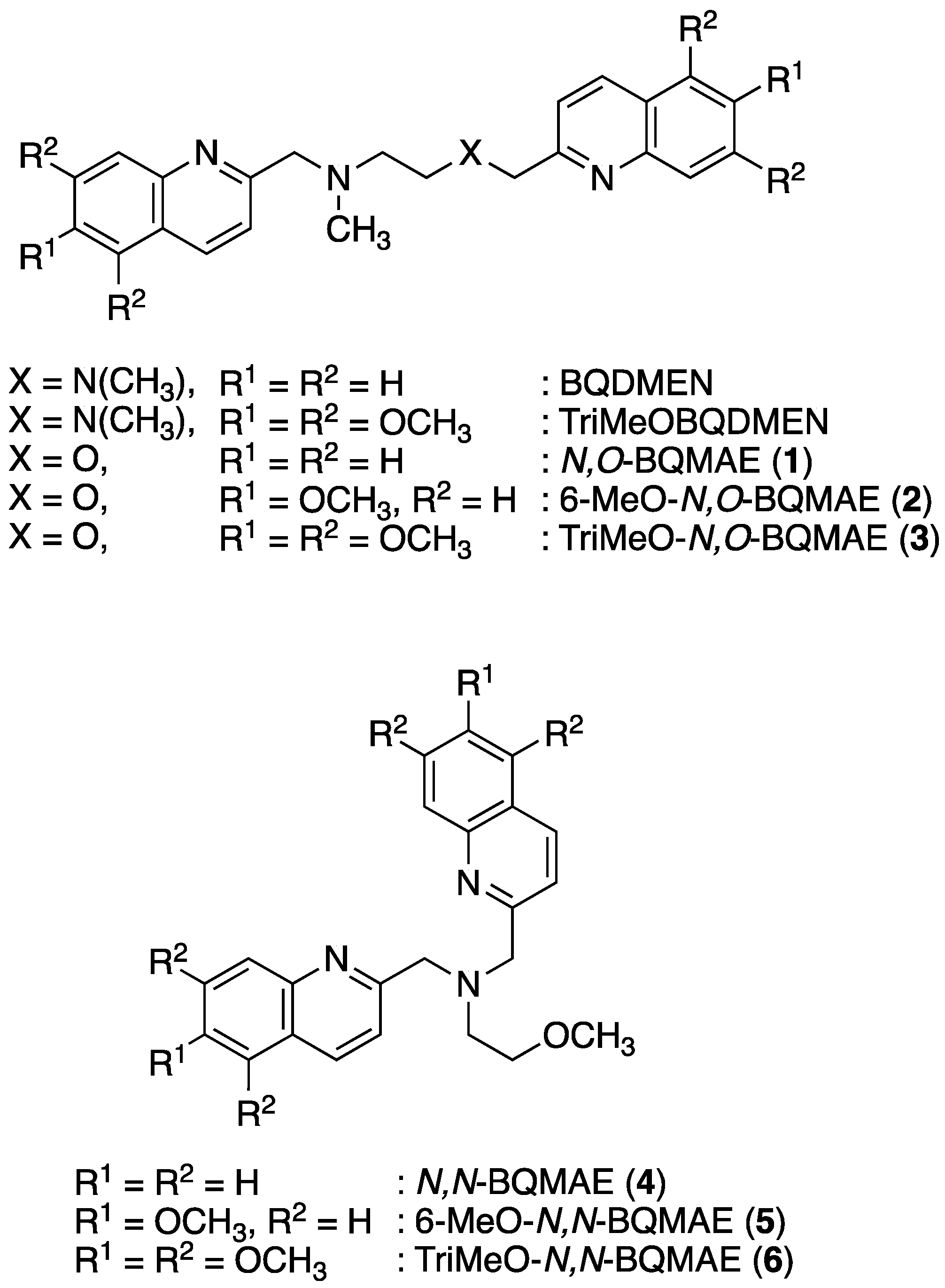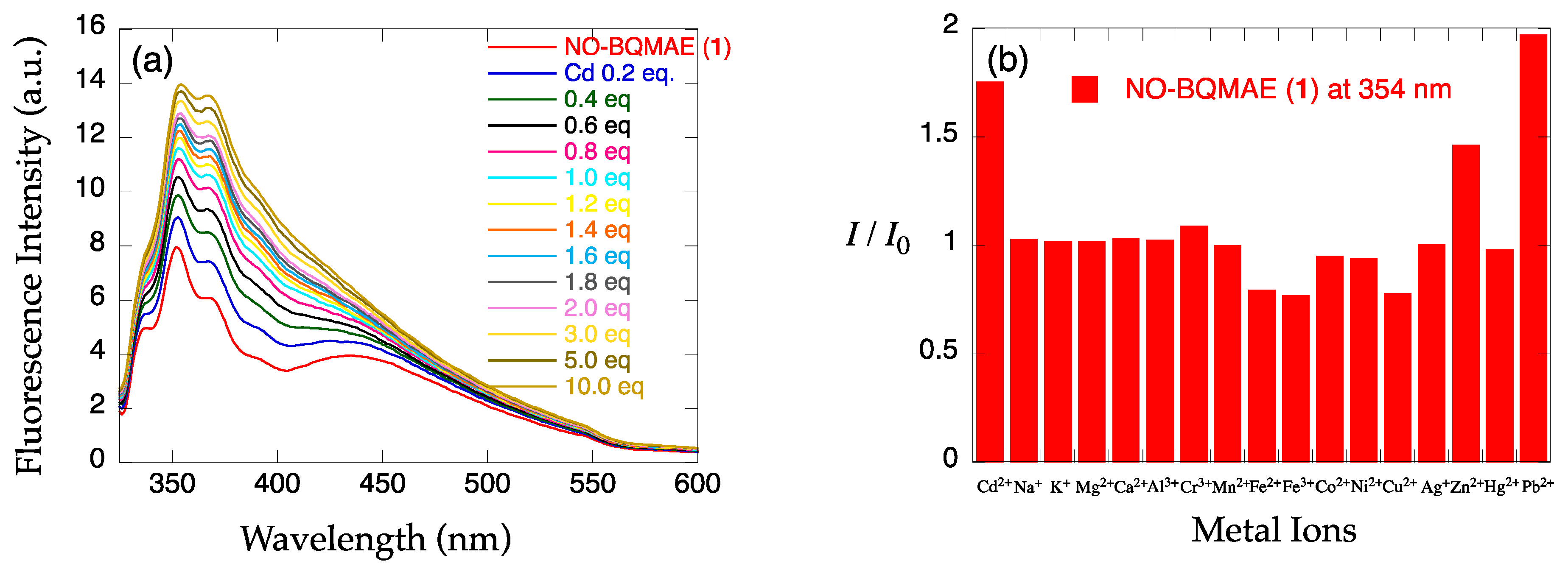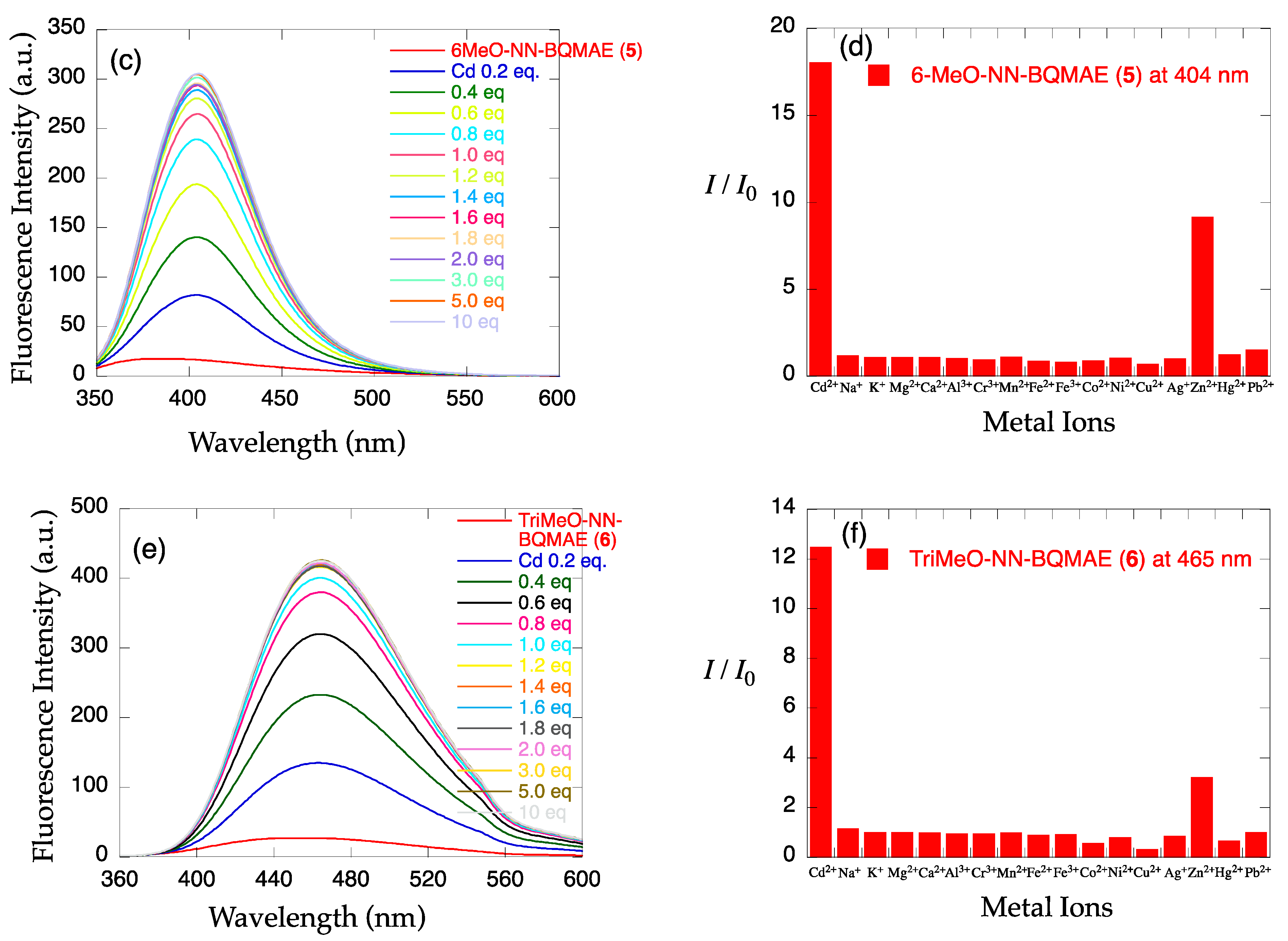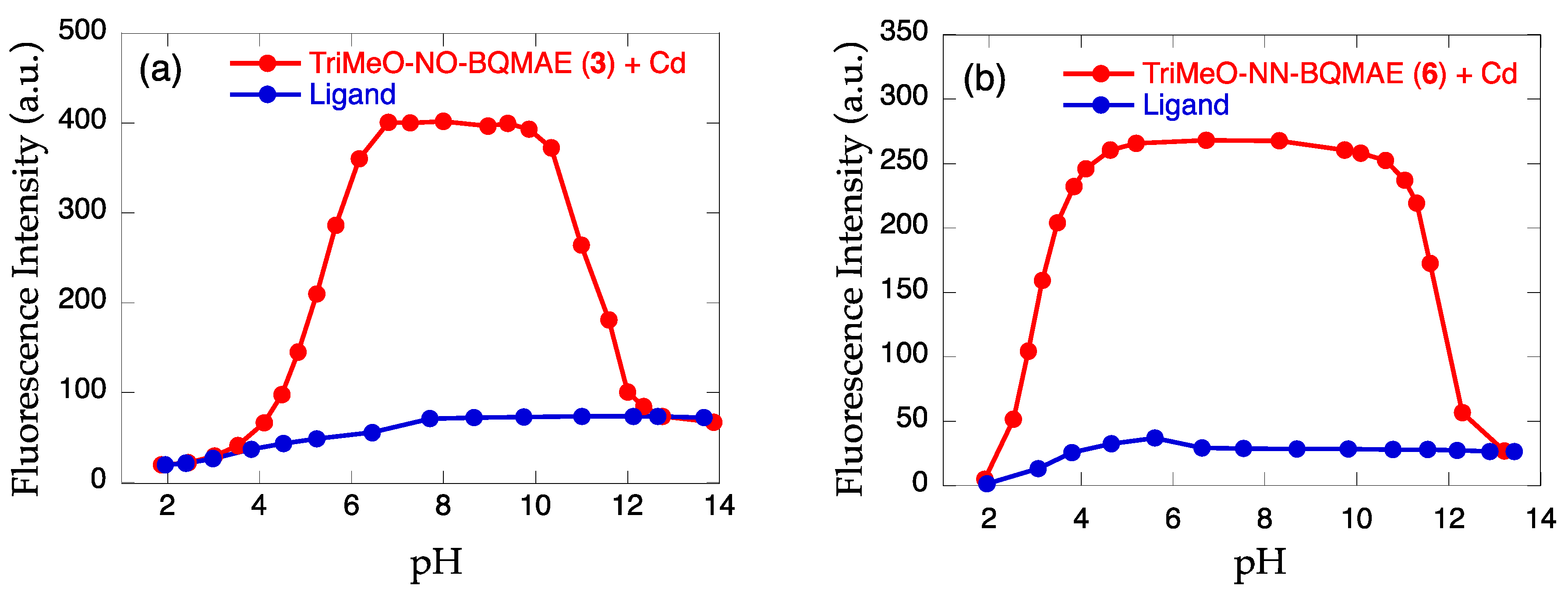Cd2+-Selective Fluorescence Enhancement of Bisquinoline Derivatives with 2-Aminoethanol Skeleton
Abstract
1. Introduction
2. Results and Discussion
2.1. Synthesis of Ligands
2.2. Fluorescence Spectral Changes of N,O-BQMAE Derivatives 1–3
2.3. Fluorescence Spectral Changes of N,N-BQMAE Derivatives 4–6
2.4. Effect of pH and Estimation of LOD
2.5. Fluorescence Lifetimes of N,O- and N,N-BQMAE Derivatives 3–6 and TriMeOBQDMEN
3. Experimental
3.1. Materials and Methods
3.2. Synthesis of N,O-Bis(2-quinolylmethyl)-2-methylaminoethanol (N,O-BQMAE (1))
3.3. Synthesis of N,O-Bis(6-methoxy-2-quinolylmethyl)-2-methylaminoethanol (6-MeO-N,O-BQMAE (2))
3.4. Synthesis of N,O-Bis(5,6,7-trimethoxy-2-quinolylmethyl)-2-methylaminoethanol (TriMeO-N,O-BQMAE (3))
3.5. Synthesis of N,N-Bis(2-quinolylmethyl)-2-methoxyethylamine (N,N-BQMAE (4))
3.6. Synthesis of N,N-Bis(6-methoxy-2-quinolylmethyl)-2-methoxyethylamine (6-MeO-N,N-BQMAE (5))
3.7. Synthesis of N,N-Bis(5,6,7-trimethoxy-2-quinolylmethyl)-2-methoxyethylamine (TriMeO-N,N-BQMAE (6))
4. Conclusions
Supplementary Materials
Author Contributions
Funding
Institutional Review Board Statement
Informed Consent Statement
Data Availability Statement
Conflicts of Interest
References
- USGS (United States Geological Survey). Mineral Commodity Summaries; United States Geological Survey: Reston, VA, USA, 2018; pp. 40–41. [Google Scholar]
- Agency for Toxic Substances and Disease Registry. 2022 Substance Priority List. Available online: https://www.atsdr.cdc.gov/SPL/#2022spl (accessed on 6 January 2024).
- Taki, M. Imaging and Sensing of Cadmium in Cells. In Metal Ions in Life Sciences; Springer Science+Business Media: Dordrecht, The Netherlands, 2013; Volume 11, pp. 99–115. [Google Scholar]
- Kim, H.N.; Ren, W.X.; Kim, J.S.; Yoon, J. Fluorescent and colorimetric sensors for detection of lead, cadmium, and mercury ions. Chem. Soc. Rev. 2012, 41, 3210–3244. [Google Scholar] [CrossRef] [PubMed]
- Khairy, M.; El-Safty, S.A.; Shenashen, M.A. Environmental remediation and monitoring of cadmium. Trends Anal. Chem. 2014, 62, 56–68. [Google Scholar] [CrossRef]
- Qian, X.; Xu, Z. Fluorescence imaging of metal ions implicated in diseases. Chem. Soc. Rev. 2015, 44, 4487–4493. [Google Scholar] [CrossRef] [PubMed]
- Wu, D.; Sedgwick, A.C.; Gunnlaugsson, T.; Akkaya, E.U.; Yoon, J.; James, T.D. Fluorescent chemosensors: The past, present and future. Chem. Soc. Rev. 2017, 46, 7105–7123. [Google Scholar] [CrossRef] [PubMed]
- Wang, X.; Shen, C.; Zhou, C.; Bu, Y.; Yan, X. Methods, principles and applications of optical detection of metal ios. Chem. Eng. J. 2021, 417, 129125. [Google Scholar] [CrossRef]
- Chen, S.-Y.; Li, Z.; Li, K.; Yu, X.-Q. Small molecular fluorescent probes for the detection of lead, cadmium and mercury ions. Coord. Chem. Rev. 2021, 429, 213691. [Google Scholar] [CrossRef]
- AbhijnaKrishna, R.; Velmathi, S. A review on fluorimetric and colorimetric detection of metal ions by chemodosimetric approach 2013–2021. Coord. Chem. Rev. 2022, 459, 214401. [Google Scholar] [CrossRef]
- Li, Z.; Hou, J.-T.; Wang, S.; Zhu, L.; He, X.; Shen, J. Recent advances of luminescent sensors for iron and copper: Platforms, mechanisms, and bio-applications. Coord. Chem. Rev. 2022, 469, 214695. [Google Scholar] [CrossRef]
- Wang, J.; Meng, Q.; Yang, Y.; Zhong, S.; Zhang, R.; Fang, Y.; Gao, Y.; Cui, X. Schiff Base Aggregation-Induced Emission Luminogens for Sensing Applications: A Review. ACS Sens. 2022, 7, 2521–2536. [Google Scholar] [CrossRef]
- Luo, D.; Huang, J.; Jian, Y.; Singh, A.; Kumar, A.; Liu, J.; Pan, Y.; Ouyang, Q. Metal–organic frameworks (MOFs) as apt luminescent probes for the detection of biochemical analytes. J. Mater. Chem. B 2023, 11, 6802–6822. [Google Scholar] [CrossRef]
- Shi, C.; Li, X.; Liu, Q.; Kushwaha, A.; Prakash, O.; Sakiyama, H.; Muddassir, M.; Kumar, A.; Liu, J. Selective and sensitive sensing of copper(II) by natural compound C-21 steroid caudatin. Polyhedron 2023, 243, 116537. [Google Scholar] [CrossRef]
- Tan, G.; Wang, S.; Yu, J.; Chen, J.; Liao, D.; Liu, M.; Nezamzadeh-Ejhieh, A.; Pan, Y.; Liu, J. Detection mechanism and the outlook of metal-organic frameworks for the detection of hazardous substances in milk. Food Chem. 2024, 430, 136934. [Google Scholar] [CrossRef] [PubMed]
- Xue, L.; Liu, C.; Jiang, H. Highly Sensitive and Selective Fluorescent Sensor for Distinguishing Cadmium from Zinc Ions in Aqueous Media. Org. Lett. 2009, 11, 1655–1658. [Google Scholar] [CrossRef] [PubMed]
- Xu, Z.; Baek, K.-H.; Kim, H.N.; Cui, J.; Qian, X.; Spring, D.R.; Shin, I.; Yoon, J. Zn2+-Triggered Amide Tautomerization Produces a Highly Zn2+-Selective, Cell-Permeable, and Ratiometric Fluorescent Sensor. J. Am. Chem. Soc. 2010, 132, 601–610. [Google Scholar] [CrossRef] [PubMed]
- Lu, C.; Xu, Z.; Cui, J.; Zhang, R.; Qian, X. Ratiometric and Highly Selective Fluorescent Sensor for Cadmium under Physiological pH Range: A New Strategy to Discriminate Cadmium from Zinc. J. Org. Chem. 2007, 72, 3554–3557. [Google Scholar] [CrossRef] [PubMed]
- Cai, Y.; Meng, X.; Wang, S.; Zhu, M.; Pan, Z.; Guo, Q. A quinoline based fluorescent probe that can distinguish zinc(II) from cadmium(II) in water. Tetrahedron Lett. 2013, 54, 1125–1128. [Google Scholar] [CrossRef]
- Xue, L.; Liu, Q.; Jiang, H. Ratiometric Zn2+ Fluorescent Sensor and New Approach for Sensing Cd2+ by Ratiometric Displacement. Org. Lett. 2009, 11, 3454–3457. [Google Scholar] [CrossRef] [PubMed]
- Mameli, M.; Aragoni, M.C.; Arca, M.; Caltagirone, C.; Demartin, F.; Farruggia, G.; De Filippo, G.; Devillanova, F.A.; Garau, A.; Isaia, F.; et al. A Selective, Nontoxic, OFF–ON Fluorescent Molecular Sensor Based on 8-Hydroxyquinoline for Probing Cd2+ in Living Cells. Chem. Eur. J. 2010, 16, 919–930. [Google Scholar] [CrossRef]
- Song, E.J.; Kang, J.; You, G.R.; Park, G.J.; Kim, Y.; Kim, S.-J.; Kim, C.; Harrison, R.G. A single molecule that acts as a fluorescence sensor for zinc and cadmium and a colorimetric sensor for cobalt. Dalton Trans. 2013, 42, 15514–15520. [Google Scholar] [CrossRef]
- Xue, L.; Li, G.; Liu, Q.; Wang, H.; Liu, C.; Ding, X.; He, S.; Jiang, H. Ratiometric Fluorescent Sensor Based on Inhibition of Resonance for Detection of Cadmium in Aqueous Solution and Living Cells. Inorg. Chem. 2011, 50, 3680–3690. [Google Scholar] [CrossRef]
- Zhang, Y.; Guo, X.; Zheng, M.; Yang, R.; Yang, H.; Jia, L.; Yang, M. A 4,5-quinolimide-based fluorescent sensor for the turn-on detection of Cd2+ with live-cell imaging. Org. Biomol. Chem. 2017, 15, 2211–2216. [Google Scholar] [CrossRef] [PubMed]
- Udhayakumari, D. A comprehensive anthology of literature based on quinoline chemosensors from 2006 to 2022. J. Mol. Struct. 2023, 1287, 135715. [Google Scholar] [CrossRef]
- Mikata, Y. Quinoline- and isoquinoline-derived ligand design on TQEN (N,N,N′,N′-tetrakis(2-quinolylmethyl)ethylenediamine) platform for fluorescent sensing of specific metal ions and phosphate species. Dalton Trans. 2020, 49, 17494–17504. [Google Scholar] [CrossRef] [PubMed]
- Mikata, Y.; Kizu, A.; Nozaki, K.; Konno, H.; Ono, H.; Mizutani, S.; Sato, S. TQOPEN (N,N,N’,N’-Tetrakis(2-quinolylmethyl)-3-oxa-1,5- pentanediamine) Family as Heptadentate Fluorescent Cd2+ Sensors. Inorg. Chem. 2017, 56, 7404–7415. [Google Scholar] [CrossRef] [PubMed]
- Mikata, Y.; Kaneda, M.; Konno, H.; Matsumoto, A.; Sato, S.; Kawamura, M.; Iwatsuki, S. Methoxy-substituted tetrakisquinoline analogs of EGTA and BAPTA for fluorescence detection of Cd2+. Dalton Trans. 2019, 48, 3840–3852. [Google Scholar] [CrossRef]
- Mikata, Y.; Tanaka, M.; Yasuda, S.; Tsuruta, A.; Hagiwara, T.; Konno, H.; Matsuo, T. Effect of methoxy substituents on fluorescent Zn2+/Cd2+ selectivity of bisquinoline derivatives with a N,N′-dimethylalkanediamine skeleton. Dalton Trans. 2023, 52, 7411–7420. [Google Scholar] [CrossRef]
- Lu, H.-L.; Wang, W.-K.; Tan, X.-X.; Luo, X.-F.; Zhang, M.-L.; Zhang, M.; Zang, S.-Q. A new quinoline-based fluorescent probe for Cd2+ and Hg2+ with an opposite response in a 100% aqueous environment and live cell imaging. Dalton Trans. 2016, 45, 8174–8181. [Google Scholar] [CrossRef]
- dos Santos Carlos, F.; da Silva, L.A.; Zanlorenzi, C.; Nunes, F.S. A novel macrocycle acridine-based fluorescent chemosensor for selective T detection of Cd2+ in Brazilian sugarcane spirit and tobacco cigarette smoke extract. Inorg. Chim. Acta 2020, 508, 119634. [Google Scholar] [CrossRef]






| Ligand | λex (nm) | λem (nm) b | IZn/ICdc | ϕCd | Kd for Cd2+ Complex (M) | Kd for Zn2+ Complex (M) |
|---|---|---|---|---|---|---|
| TriMeO-N,O-BQMAE (3) | 338 | 470 | 34% | 0.281 d | (1.4 ± 0.2) × 10−5 | (8.2 ± 0.4) × 10−5 |
| N,N-BQMAE (4) | 317 | 366 | 87% | 0.018 d | (8.1 ± 1.5) × 10−6 | (5.2 ± 0.3) × 10−5 |
| 6-MeO-N,N-BQMAE (5) | 337 | 404 | 51% | 0.171 d | (6.4 ± 0.3) × 10−7 | (1.6 ± 0.2) × 10−5 |
| TriMeO-N,N-BQMAE (6) | 340 | 465 | 26% | 0.228 d | ~10−7 | (1.5 ± 0.2) × 10−5 |
| TriMeOBQDMEN | 335 | 458 | 24% (41% e) | 0.293 c,e | (2.6 ± 1.0) × 10−7 | (2.7 ± 0.5) × 10−6 |
| Ligand | Metal Ion | λem (nm) | BPF (nm) c | τ (nsec) d |
|---|---|---|---|---|
| TriMeO-N,O-BQMAE (3) | — | — | 460 | 1.2 (17%), 4.3 (74%), 14.5 (9%) |
| Cd2+ | 470 | 460 | 2.6 (5%), 11.5 (14%), 29.7 (81%) | |
| Zn2+ | 484 | 460 | 2.1 (14%), 7.5 (34%), 22 (52%) | |
| N,N-BQMAE (4) | — | — | 370 | 1.2 (14%), 5.5 (40%) |
| Cd2+ | 364 | 370 | 5.4 (20%) | |
| Zn2+ | 370 | 370 | 1.0 (43%), 5.3 (22%) | |
| 6-MeO-N,N-BQMAE (5) | — | — | 400 | 2.7 (45%), 6.0 (46%) |
| Cd2+ | 404 | 400 | 1.1 (5%), 3.0 (1%), 6.2 (94%) | |
| Zn2+ | 408 | 400 | 3.4 (27%), 6.8 (66%) | |
| TriMeO-N,N-BQMAE (6) | — | — | 460 | 1.2 (34%), 4.0 (24%), 16.8 (42%) |
| Cd2+ | 465 | 460 | 1.6 (2%), 8.5 (7%), 17.7 (91%) | |
| Zn2+ | 480 | 490 | 1.2 (12%), 7.4 (33%), 16.5 (54%) | |
| TriMeOBQDMEN | — | — | 460 | 1.1 (29%), 4.3 (44%), 21.4 (27%) |
| Cd2+ | 472 | 460 | 3.5 (1%), 14.6 (5%), 31.8 (91%) | |
| Zn2+ | 487 | 490 | 1.7 (2%), 7.8 (9%), 20.2 (88%) |
Disclaimer/Publisher’s Note: The statements, opinions and data contained in all publications are solely those of the individual author(s) and contributor(s) and not of MDPI and/or the editor(s). MDPI and/or the editor(s) disclaim responsibility for any injury to people or property resulting from any ideas, methods, instructions or products referred to in the content. |
© 2024 by the authors. Licensee MDPI, Basel, Switzerland. This article is an open access article distributed under the terms and conditions of the Creative Commons Attribution (CC BY) license (https://creativecommons.org/licenses/by/4.0/).
Share and Cite
Mikata, Y.; Tsuruta, A.; Koike, H.; Shoji, S.; Konno, H. Cd2+-Selective Fluorescence Enhancement of Bisquinoline Derivatives with 2-Aminoethanol Skeleton. Molecules 2024, 29, 369. https://doi.org/10.3390/molecules29020369
Mikata Y, Tsuruta A, Koike H, Shoji S, Konno H. Cd2+-Selective Fluorescence Enhancement of Bisquinoline Derivatives with 2-Aminoethanol Skeleton. Molecules. 2024; 29(2):369. https://doi.org/10.3390/molecules29020369
Chicago/Turabian StyleMikata, Yuji, Aya Tsuruta, Hinata Koike, Sunao Shoji, and Hideo Konno. 2024. "Cd2+-Selective Fluorescence Enhancement of Bisquinoline Derivatives with 2-Aminoethanol Skeleton" Molecules 29, no. 2: 369. https://doi.org/10.3390/molecules29020369
APA StyleMikata, Y., Tsuruta, A., Koike, H., Shoji, S., & Konno, H. (2024). Cd2+-Selective Fluorescence Enhancement of Bisquinoline Derivatives with 2-Aminoethanol Skeleton. Molecules, 29(2), 369. https://doi.org/10.3390/molecules29020369








